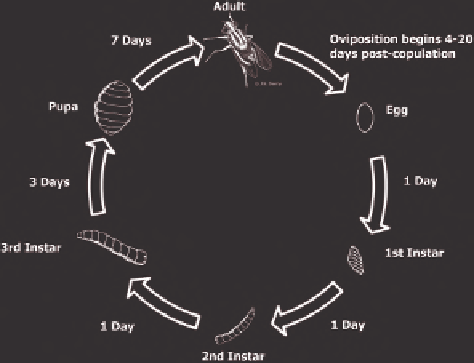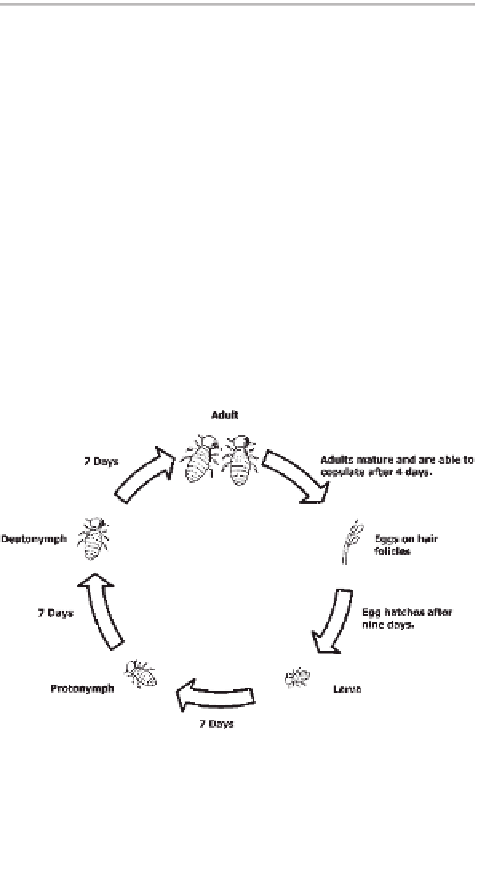Agriculture Reference
In-Depth Information
ity, thus leading to scours (sometimes bloody), unthrifti-
ness, weight loss/reduced weight gains, and sometimes
death. It is a disease associated with fi lth, moisture, and
times of depressed immunity such as kidding, weaning, or
during transportation. Devastating losses can occur quickly
because of the asexual process and usually are a problem
at weaning when kids are stressed. Preventing and/or con-
trolling coccidiosis can be achieved by providing an anti-
coccidial product in the feed or water. There are several
effective products on the market, such as amprolium, deco-
quinate, lasalosid, and monensin. Individual clinical cases
can be treated with sulfa products. Secondary bacterial
infection is common, so antibiotics may be needed. In
order to reestablish healthy intestinal fl ora after recovery,
probiotics are advised. There is no vaccine for coccidiosis.
Fortunately, a solid immunity develops subsequent to
infection; however, if infection was severe, stunting
usually results.
A
B
EXTERNAL PARASITES (ARTHROPODS)
External parasites can limit production. They feed on
blood and organic debris. Infestation can cause discomfort,
irritation, and pruritus (itching). Consequences of infesta-
tion can be skin damage, open lesions, reduced weight
gains or weight loss, reduced milk production, and trans-
mission of some diseases from sick to healthy animals.
General Life Cycles
The life cycle of arthropods involve a series of structural
changes known as metamorphosis, the actual sequence of
which varies with different parasite groups. Complete
metamorphosis (Figure 11.3A) begins when adults lay
eggs from which larvae hatch. The larvae grow and shed
their skins (moult) several times, each time to accommo-
date their increases in size. Eventually a hard-cased struc-
ture called a pupa is formed, which may have the capacity
to survive winter. The pupa hatches into the adult parasite,
the fi nal stage of metamorphosis. Thus, there are four
distinct stages: egg, larva, pupa, and adult. Incomplete
metamorphosis (Figure 11.3B) involves a larva that grows
and moults one or more times to become an adult-like form
known as a nymph, which in turn grows and moults one
or more times to become an adult. In this case larvae,
nymphs, and adults all look similar but different in size.
Figure 11.3
(A) The life cycle of arthropods
(complete metamorphosis) (J.J. Garza and J.B.
Denny, Louisiana State University). (B) The life
cycle of arthropods (incomplete metamorphosis)
(J.J. Garza, Louisiana State University).
irritating and can result in reduced foraging that may lead
to production losses. Blood loss due to large numbers of
blood - feeding fl ies (mosquitoes, black fl ies, horn fl ies,
stable fl ies, tabanid fl ies, etc.) may lead to anemia, unthrift-
iness, and weight loss/reduced gains. Larvae (maggots) of
nonblood - feeding nuisance fl ies can invade living and
necrotic animal tissue causing a condition called myiasis.
Nasal bot fl ies (
Oestrus ovis
) primarily affect sheep but
can be a problem for goats. They exhibit a unique quality
by depositing live larvae in the nostrils. Infested animals
usually have a nasal discharge that is sometimes blood
tinged. Affected animals may shake their heads, grind their
teeth, and be anorexic (loss of appetite). Larvae migrate
Flies
Flies undergo complete metamorphosis. There are a
number of fl y species, which are primarily a nuisance,
especially under confi nement conditions. The fl y season is
spring/summer. The constant buzzing of nuisance fl ies is







